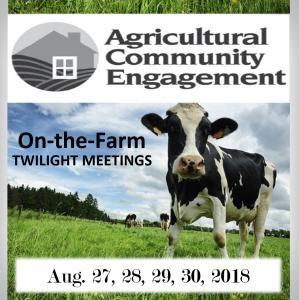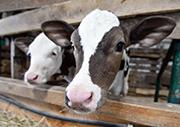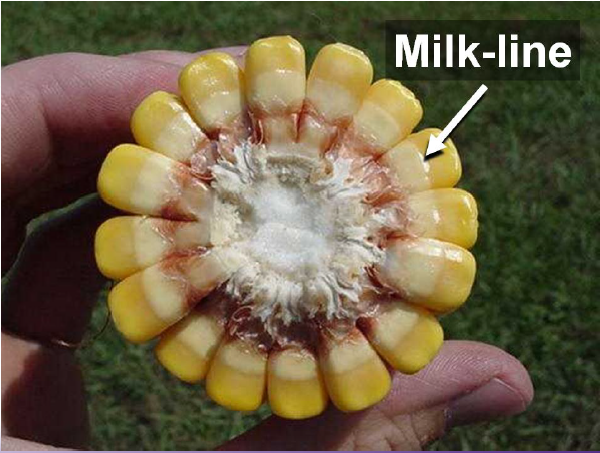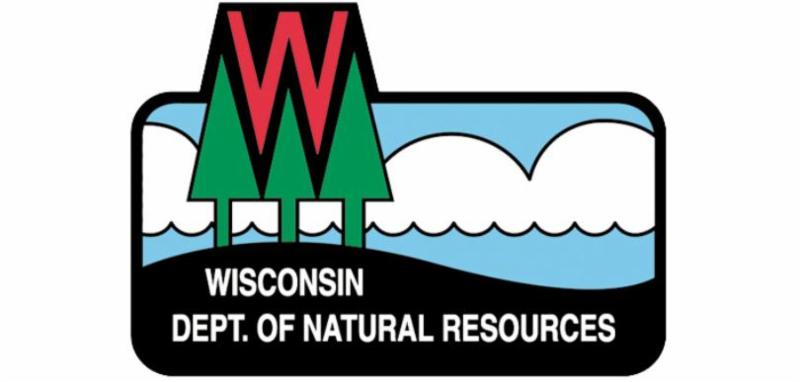|
Brought to you by Dairy's Professional Development Organization®
|
|
Opportunities to learn...

ON-THE-FARM TWILIGHT MEETINGS BRING TOGETHER
local community leaders and dairy producers to discuss important issues and learn together. Invite your friends and neighbors to attend these events hosted by the Agricultural Community Engagement partnership of Wisconsin Towns Association, Wisconsin Counties Association and PDPW. Meetings begin with a one-hour tour of the host dairy farm from 6:00 to 7:00 p.m., followed by ice cream, facilitated discussion and open dialogue. Events will be held:
- Mon., Aug. 27: Kellercrest Holsteins, 1141 County Highway JG South, Mt. Horeb, WI 53572
- Tue., Aug. 28: Miltrim Farms, 1715 W Townline Rd., Athens, WI 54411
- Wed., Aug. 29: Brey Cycle Farm LLC, 2139 County Road O, Sturgeon Bay, WI 54235
- Thu., Aug. 30: Double S Dairy, N3447 Marshview Rd., Markesan, WI 53946
These are FREE community events, for additional information, click
here
, call 800-947-7379 or email mail@pdpw.org.
CHECK OUT DAIRY ADVANCE®
This award-winning continuing-education tracker enables farmers and their team members to easily track their CE credits and advancement toward their professional-development goal. The online tool, powered by PDPW, is free for dairy producers and continues to grow in the number of accredited education providers and subscribers.
In addition to farmers and their team members, college students and those in allied industries are using Dairy AdvanCE to track and report their transcripts as an official record of their ongoing education to employers, lenders, community boards, agents, and more. Find, track and report your Continuing Education (CEs). Get more details at
DairyAdvance.org
.
|
For your dairy...
 THE IMPACT OF PERSONALITY ON PERFORMANCE AND FEEDING BEHAVIOR was the focus of a study in the Journal of Dairy Science. Researchers studied 56 dairy calves in groups of 8 calves each with access to an automated milk feeder and unlimited access to water, starter and hay. They measured starter dry matter intake and unrewarded visits to the automatic feeder during four periods and subjected calves twice to novelty tests to evaluate their personality and behavior. Calves that were more "exploratory-active" began to consume starter at an earlier age and showed greater overall average daily gain. Read more about the tests and results here. THE IMPACT OF PERSONALITY ON PERFORMANCE AND FEEDING BEHAVIOR was the focus of a study in the Journal of Dairy Science. Researchers studied 56 dairy calves in groups of 8 calves each with access to an automated milk feeder and unlimited access to water, starter and hay. They measured starter dry matter intake and unrewarded visits to the automatic feeder during four periods and subjected calves twice to novelty tests to evaluate their personality and behavior. Calves that were more "exploratory-active" began to consume starter at an earlier age and showed greater overall average daily gain. Read more about the tests and results here.

MONITORING SILAGE CROP CONDITIONS AND MOISTURE SAMPLING
are key to maximizing both quality and yield for silage harvest. Tracking
planting and silking dates
will help estimate potential maturity dates. Once corn silks, approximately 55 to 60 days are required to achieve maturity at R6
or the "black layer" stage. Though kernel milk line can provide a rough estimate of moisture, a commercial forage moisture tester, food dehydrator or microwave oven should be used for more accurate measurement; 10 to 15 representative stalks from throughout the field should be included in sample. Click
here
for more details and step-by-step instructions.
|
PREPARE NOW TO ENSURE ALL SYSTEMS ARE "GO" FOR HARVEST.
Each year farmers face a time crunch for getting hay, silage and other crops harvested. That time pressure can lead to mistakes that result in injuries or equipment damage. Experts at UW-Extension Center for Agricultural Safety & Health encourage farmers to approach harvest machinery like a pilot or NASCAR driver would - with a detailed pre-harvest checklist that includes ensuring all appropriate shields are in place; replacing potentially unsafe hydraulic hoses, bearings and belts; and equipping each machine and vehicle with a fully charged 10-pound ABC dry chemical fire extinguisher. Read more at the
UW Agricultural Safety and Health Center
website
.
 DON'T MISS DEADLINE FOR PRODUCER-LED WATERSHED PROTECTION GRANTS.
Wisconsin Department of Agriculture, Trade and Consumer Protection offers grants to farmer-led projects that focus on ways to prevent and reduce runoff from farm fields while working to increase farm participation in voluntary efforts. Each application must come from groups of at least five farmers in the same watershed collaborating with conservation agencies, institutions or nonprofit organizations. The application deadline for 2019 funding is September 19. For more information on
producer-led watershed-protection grants, click
here
. DON'T MISS DEADLINE FOR PRODUCER-LED WATERSHED PROTECTION GRANTS.
Wisconsin Department of Agriculture, Trade and Consumer Protection offers grants to farmer-led projects that focus on ways to prevent and reduce runoff from farm fields while working to increase farm participation in voluntary efforts. Each application must come from groups of at least five farmers in the same watershed collaborating with conservation agencies, institutions or nonprofit organizations. The application deadline for 2019 funding is September 19. For more information on
producer-led watershed-protection grants, click
here
.
In addition, a list of farm tours, talks and field-day events are updated monthly at the
DATCP
website
. To post your event on their site, contact Rachel Rushmann at 608-224-4622 or by
email
. Here's a list of some upcoming events:
- Aug. 1 - Farmers for Lake Country: Shed Talks Conservation Efforts That Make $$ and Sense, Oconomowoc
- Aug. 3 - Dodge County Farmers for Healthy Soil-Healthy Water with Discovery Farms Field Day, Beaver Dam
- Aug. 8 - Farmers for Lake Country: Shed Talks Conservation Efforts That Make $$ and Sense, Richfield
- Aug. 21 - Farmers of the Sugar River: Summer Soils Field Day, Juda
- Sept. 6 - Watershed Protection Committee of Racine County (WPCR) Field Day
- Oct. 4 - Lafayette County RCPP project: Conservation Field Day, Blanchardville
 WISCONSIN WETLAND UPDATE: NEW EXEMPTIONS EFFECTIVE JULY 1, 2018.
According to Jordan Lamb, attorney with DeWitt Ross & Stevens, two new wetland exemptions that were created as a result of 2018 Wisconsin Act 183, and which govern the placement of fill in "artificial wetlands" and "nonfederal wetlands," went into effect on July 1, 2018. WISCONSIN WETLAND UPDATE: NEW EXEMPTIONS EFFECTIVE JULY 1, 2018.
According to Jordan Lamb, attorney with DeWitt Ross & Stevens, two new wetland exemptions that were created as a result of 2018 Wisconsin Act 183, and which govern the placement of fill in "artificial wetlands" and "nonfederal wetlands," went into effect on July 1, 2018.
Act 183 created two new exemptions under Wisconsin's wetland permitting program: one for impacts to artificial wetlands and one for small impacts to nonfederal wetlands. Artificial wetlands are landscape features where hydrophytic vegetation may be present as a result of human modification to the landscape or hydrology and which lack definitive evidence of a wetland or stream history prior to August 1, 1991. The artificial wetlands exemption provides that if the wetland is "artificial" then it can be filled with no mitigation and no state permitting requirement. There is no maximum size limitation for this exemption.
However, this new exemption only affects the state wetland program. No equivalent changes were made to the federal wetland program. As a result, it is possible that a permit from the United States Army Corps of Engineers (USACE) may still be required. NRCS Swampbuster is also still applicable and valid in artificial wetlands.
Nonfederal wetlands are defined as wetlands that are not subject to federal jurisdiction under 33 USC 1344. To determine if a wetland meets this definition, a jurisdictional analysis must be done by the United States Army Corps of Engineers (ACOE). The new exemption provides an alternative permit structure for impacts to nonfederal wetlands of a certain size. For urban wetland projects to qualify, the activity may not affect more than 1 acre of wetlands. For rural wetland projects, the activity may not affect more than 3 acres of wetlands. Anyone seeking qualification under this exemption must also determine whether other regulations, such as NRCS Swampbuster, still apply.
To facilitate the implementation of these two new exemptions, the DNR is developing two new guidance documents for the implementation of Act 183. One guidance document will address "artificial wetlands" and the other document will outline the permitting program for certain impacts to "nonfederal wetlands." The two documents will be available on the DNR's website shortly and are designed to help landowners determine eligibility for the two new exemptions through a step-by-step process, and to provide helpful resources and examples.
Anyone seeking coverage under either of these two new exemptions should start by going to the DNR's website to gather the appropriate information for an application.
|
For your business mind...
 SMART HIRING STARTS WITH JOB DESCRIPTIONS
according to an article from Penn State University Extension. A good job description can not only help you identify the best candidate for a job, but also recruit top-quality candidates because they'll have a clear idea of the job requirements and expected day-to-day tasks. When writing job descriptions, key elements to include are job title, summary, qualifications, duties or tasks and work relationships. Optional items can include an overview of compensation and benefits and job schedule. Click here to learn more and to access an online job-description generator. SMART HIRING STARTS WITH JOB DESCRIPTIONS
according to an article from Penn State University Extension. A good job description can not only help you identify the best candidate for a job, but also recruit top-quality candidates because they'll have a clear idea of the job requirements and expected day-to-day tasks. When writing job descriptions, key elements to include are job title, summary, qualifications, duties or tasks and work relationships. Optional items can include an overview of compensation and benefits and job schedule. Click here to learn more and to access an online job-description generator.
 CALCULATING BREAK-EVEN COST OF PRODUCTION is important at all times, but especially critical during low-margin periods. An article written by Jason Karszes of Cornell CALS PRO-DAIRY outlines several measures of how cost of production could be calculated for your farm, each with different implications. He notes that it is important to use accrual or accrual adjusted income and expenses to make the numbers a meaningful measurement for the business. Click here to see cost calculations with example data. CALCULATING BREAK-EVEN COST OF PRODUCTION is important at all times, but especially critical during low-margin periods. An article written by Jason Karszes of Cornell CALS PRO-DAIRY outlines several measures of how cost of production could be calculated for your farm, each with different implications. He notes that it is important to use accrual or accrual adjusted income and expenses to make the numbers a meaningful measurement for the business. Click here to see cost calculations with example data.

GETTING OFF TO THE RIGHT START AS A NEW MANAGER
can be challenging. Handling new responsibilities along with policies and regulations that may come with the management role requires a blend of people and organizational skills. This article has several recommendations for new managers including:
- Get to know your staff early and let them get to know you
- You're the manager, not the friend - or therapist, or social director
- Consistency with - and between - staff members is critical
- Clear goals make it easier to evaluate employee success
- Developing goals together improves employee engagement
- You don't need to have all the answers
Click
here
for the full article and examples of each recommendation.
|
"If your actions inspire others to dream more, learn more, and become more, you are a leader."
--- John Quincy Adams
|
Podcast

PODCAST - LIVE INSPIRED - JOHN O'LEARY John O'Leary inspired attendees at the 2018 PDPW Business Conference with his story of not just surviving after near-fatal burns as a child but reaching levels of success many people never attain. O'Leary's weekly "Live Inspired" podcasts feature interviews with a wide range of authors, speakers and individuals who have their own inspiring stories to tell, including a recent episode featuring Apollo 13 Commander Jim Lovell. Click here for access to archives of episodes so you can listen on your computer, or subscribe on iTunes, Stitcher and other services.
|
|
A BIG Thank You...
TO THE PDPW SPONSORS who are supporting your professional development organization! As a producer-led group,we extend a heart-felt "Thank You!" to those that stand alongside our nation's dairy farmers. T
heir support allows PDPW to execute best-in-class producer training and has enabled us to become the go-to resource for unified outreach initiatives. If you or a company you know is interested in participating as a sponsor, please contact us at abonomie@pdpw.org or call 800-947-7379.
See the full list of generous sponsors
here.
|
|
PDPW Education Calendar
| August 27-30 |
PDPW ACE On-the-Farm Twilight Meetings: Mt. Horeb, Athens, Sturgeon Bay & Markesan, Wis.
|
| Jan. 15-17, 2019 |
2019 PDPW Managers Academy for Dairy Professionals: South Carolina
|
| Mar. 13-14, 2019 |
2019 PDPW Business Conference: Madison, Wis.
|
STAY CONNECTED
800-947-7379
|
|
|
|
|